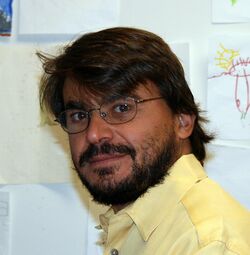Biography:Michael T. Ullman
Michael Thomas Ullman | |
|---|---|
 | |
| Born | July 29, 1962 San Francisco, California, USA |
| Nationality | American |
| Alma mater | Massachusetts Institute of Technology (MIT) Harvard University |
| Known for | Declarative/Procedural Model of language |
| Scientific career | |
| Fields | Neuroscience |
| Institutions | Georgetown University |
Michael T. Ullman (born July 29, 1962, San Francisco, California) is an American neuroscientist whose main field of research is the relationship between language, memory and the brain. His Declarative/Procedural model of language[1][2][3] has greatly affected the field of psycholinguistics and cognitive neuroscience.
Early life and career
Ullman was born in San Francisco, California. He is an alumnus of the French American International School and Lowell High School (1976–1980), both in San Francisco. He received his BA in Computer Science from Harvard University in 1988 and his PhD from the Department of Brain and Cognitive Sciences, Massachusetts Institute of Technology in 1993. Ullman is currently a full professor at Georgetown University.[4] His primary appointment is in the Department of Neuroscience (Georgetown University Medical Center),[5] with secondary appointments in the Departments of Linguistics,[6] Neurology[7] and Psychology.[8] He is the founding Director of the Brain and Language Lab,[9] founding co-Director of the Center for the Brain Basis of Cognition,[10] and founding Director of the Georgetown Cognitive Neuroscience EEG/ERP Center.[11][12] He was a Presidential Columnist for American Psychological Society Observer in 2005.[13] He currently lives in Washington D.C. with his daughter Clementina Ullman.
References
- ↑ Ullman, M.T. (2004) Contributions of memory circuits to language: the declarative/procedural model. Cognition. 92. pp. 231–270. "Archived copy". http://brainlang.georgetown.edu/PUBS/Ullman_Cognition_04.pdf.
- ↑ Ullman, M. T., Corkin, S., Coppola, M., Hickok, G., Growdon, J. H., Koroshetz, W. J. Pinker, S. (1997). The Journal of Cognitive Neuroscience, Vol 9, 266–276 [1]
- ↑ Ullman, M. T. (2001). A neurocognitive perspective on language: The declarative/procedural model. Nature Reviews Neuroscience, 2, 717–726. [2]
- ↑ Michael T. Ullman's homepage at the Brain and Language Lab, Georgetown University "Lab Director - Brain and Language Lab". http://brainlang.georgetown.edu/director.htm.
- ↑ "Department of Neuroscience, Georgetown University Medical Center". Neuro.georgetown.edu. http://neuro.georgetown.edu/home.html.
- ↑ Department of Linguistics. "Department of Linguistics, Georgetown University". Linguistics.georgetown.edu. http://linguistics.georgetown.edu/.
- ↑ "Department of Neurology, Georgetown University Medical Center". Gumc.georgetown.edu. September 14, 2010. http://gumc.georgetown.edu/departments/neurology/.
- ↑ Department of Psychology, Georgetown University
- ↑ "Brain and Language Lab, Georgetown University". Brainlang.georgetown.edu. http://brainlang.georgetown.edu.
- ↑ "Center for the Brain Basis of Cognition, Georgetown University". Cbbc.georgetown.edu. http://cbbc.georgetown.edu.
- ↑ Georgetown Cognitive Neuroscience EEG/ERP Center
- ↑ "Curriculum Vitae – Michael T. Ullman (Retrieved: 2007-10-09)". http://brainlang.georgetown.edu/People/M_T_Ullman_CV.pdf.
- ↑ Ullman, M., T. (2005). More Is Sometimes More: Redundant mechanisms in the mind and brain. APS Observeer, Volume 18, Number 12. [3]
External links
- Homepage at Georgetown University
- Brain and Language Lab at Georgetown University
- Center for the Brain Basis of Cognition at Georgetown University
- Georgetown Cognitive Neuroscience EEG/ERP Center

